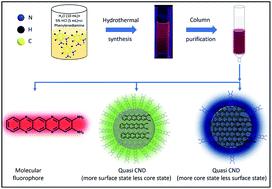当前位置:
X-MOL 学术
›
Chem. Sci.
›
论文详情
Our official English website, www.x-mol.net, welcomes your feedback! (Note: you will need to create a separate account there.)
Absorption and emission of light in red emissive carbon nanodots
Chemical Science ( IF 8.4 ) Pub Date : 2021-1-14 , DOI: 10.1039/d0sc05879c Neeraj Soni 1, 2 , Shivendra Singh 1, 2 , Shubham Sharma 1, 2 , Gayatri Batra 1, 2 , Kush Kaushik 1, 2 , Chethana Rao 1, 2 , Navneet C Verma 1, 2 , Bhaskar Mondal 1 , Aditya Yadav 1, 2 , Chayan K Nandi 1, 2, 3
Chemical Science ( IF 8.4 ) Pub Date : 2021-1-14 , DOI: 10.1039/d0sc05879c Neeraj Soni 1, 2 , Shivendra Singh 1, 2 , Shubham Sharma 1, 2 , Gayatri Batra 1, 2 , Kush Kaushik 1, 2 , Chethana Rao 1, 2 , Navneet C Verma 1, 2 , Bhaskar Mondal 1 , Aditya Yadav 1, 2 , Chayan K Nandi 1, 2, 3
Affiliation

|
The structure–function relationship, especially the origin of absorption and emission of light in carbon nanodots (CNDs), has baffled scientists. The multilevel complexity arises due to the large number of by-products synthesized during the bottom-up approach. By performing systematic purification and characterization, we reveal the presence of a molecular fluorophore, quinoxalino[2,3-b]phenazine-2,3-diamine (QXPDA), in a large amount (∼80% of the total mass) in red emissive CNDs synthesized from o-phenylenediamine (OPDA), which is one of the well-known precursor molecules used for CND synthesis. The recorded NMR and mass spectra tentatively confirm the structure of QXPDA. The close resemblance of the experimental vibronic progression and the mirror symmetry of the absorption and emission spectra with the theoretically simulated spectra confirm an extended conjugated structure of QXPDA. Interestingly, QXPDA dictates the complete emission characteristics of the CNDs; in particular, it showed a striking similarity of its excitation independent emission spectra with that of the original synthesized red emissive CND solution. On the other hand, the CND like structure with a typical size of ∼4 nm was observed under a transmission electron microscope for a blue emissive species, which showed both excitation dependent and independent emission spectra. Interestingly, Raman spectroscopic data showed the similarity between QXPDA and the dot structure thus suggesting the formation of the QXPDA aggregated core structure in CNDs. We further demonstrated the parallelism in trends of absorption and emission of light from a few other red emissive CNDs, which were synthesized using different experimental conditions.
中文翻译:

红色发射碳纳米点的吸收和发射光
结构与功能的关系,特别是碳纳米点(CND)中光的吸收和发射的起源,使科学家感到困惑。由于自下而上方法中合成了大量的副产物,因此出现了多级复杂性。通过进行系统的纯化和表征,我们以红色显示了大量(约占总质量的80%)分子荧光团喹喔啉[2,3 - b ]吩嗪-2,3-二胺(QXPDA)的存在。由o合成的发射CND-苯二胺(OPDA),它是用于CND合成的众所周知的前体分子之一。记录的NMR和质谱初步证实了QXPDA的结构。实验的电子振动过程与吸收光谱和发射光谱与理论模拟光谱的镜像对称性非常相似,证实了QXPDA的扩展共轭结构。有趣的是,QXPDA决定了CND的完整发射特性。特别是,它显示出其独立于激发的发射光谱与原始合成的红色发射CND溶液的惊人相似性。另一方面,在透射电子显微镜下观察到蓝色发射物种的CND样结构,典型尺寸约为4 nm,显示了激发相关和独立的发射光谱。有趣的是,拉曼光谱数据显示了QXPDA与点结构之间的相似性,从而暗示了CND中QXPDA聚集核结构的形成。我们进一步证明了在使用不同实验条件合成的其他一些红色发射CND的光吸收和发射趋势中的平行性。
更新日期:2021-01-26
中文翻译:

红色发射碳纳米点的吸收和发射光
结构与功能的关系,特别是碳纳米点(CND)中光的吸收和发射的起源,使科学家感到困惑。由于自下而上方法中合成了大量的副产物,因此出现了多级复杂性。通过进行系统的纯化和表征,我们以红色显示了大量(约占总质量的80%)分子荧光团喹喔啉[2,3 - b ]吩嗪-2,3-二胺(QXPDA)的存在。由o合成的发射CND-苯二胺(OPDA),它是用于CND合成的众所周知的前体分子之一。记录的NMR和质谱初步证实了QXPDA的结构。实验的电子振动过程与吸收光谱和发射光谱与理论模拟光谱的镜像对称性非常相似,证实了QXPDA的扩展共轭结构。有趣的是,QXPDA决定了CND的完整发射特性。特别是,它显示出其独立于激发的发射光谱与原始合成的红色发射CND溶液的惊人相似性。另一方面,在透射电子显微镜下观察到蓝色发射物种的CND样结构,典型尺寸约为4 nm,显示了激发相关和独立的发射光谱。有趣的是,拉曼光谱数据显示了QXPDA与点结构之间的相似性,从而暗示了CND中QXPDA聚集核结构的形成。我们进一步证明了在使用不同实验条件合成的其他一些红色发射CND的光吸收和发射趋势中的平行性。


























 京公网安备 11010802027423号
京公网安备 11010802027423号